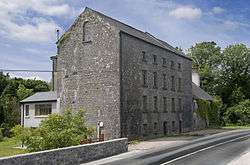Cregg Mill
|
Cregg Mill and miller's cottage | |
| Flour mill | |
|---|---|
| Architectural style | Standing, usage changed |
| Structural system | Limestone |
| Location | Corrandulla, County Galway |
| Coordinates | 53°23′15″N 8°58′26″W / 53.3875°N 8.973889°W |
| Construction | |
| Built | c.1780 |
| Renovated |
|
| Floor count | 4 (originally 3) |
| References | |
| "Cregg Mill webpage". Retrieved 2014-09-03. | |
Cregg Mill is a converted 18th century watermill located near Corrandulla village in County Galway, Ireland, approximately 9 miles from Galway City. The mill serviced the local area, including neighbouring Cregg Castle, and served as a feeding centre for the poor of Corrandulla during the Great Famine. An advertisement in the early twentieth century shows that wheat, rye, corn, oats, and barley were kiln dried and ground there.[1]
The mill is situated on the Cregg River which rises from a spring a half mile to the north, and flows into Lough Corrib.
History
The Mill was built around 1780,[2] and the first edition (1842) of the Ordnance Survey Ireland map shows that, originally, three watermills stood at the Cregg River bridge. However, due to the effects of the 1845-1852 Great Famine, only one mill was mentioned as functioning in the 1853 edition of Griffith's valuation, with Patrick Wade listed as the miller. The miller's cottage adjoins the Mill. In the third edition (1913) of the Ordnance Survey Ireland map only the current Cregg Mill is standing, and it is marked as "Flour Mill in ruins".
In 1918 a newspaper article noted that "efforts are being made to re-establish the Cregg Corn Mills, Annaghdown, on a co-operative basis" to service the local farmers.[3] By 1919 work had commenced on repairing the mill to a working condition, and readers were urged to buy the "few shares left" in the co-operative and assist in "establishing an industry that shall remain as a monument to their patriotism and business accumen".[4] The co-operative was named "Harward Wade, Son and Co., LTD."
By 1935 the company had gone bankrupt and the initiative ended in acrimony, with Francis Brennan Wade applying for the winding up of the company.[5] But in 1940, Francis Brennan Wade began advertising the mill as open again for business.[6]
In 1953 the ESB had its local headquarters at the mill for the Rural Electrification scheme, with the notice stating that 325 houses in the area were ready for wiring.[7]
By 1958 the mill was again for sale as a working mill, with the equipment listed as: "a modern tiled drying kiln...2 pair French burr stones, 1 pair shelling stones for oatmeal, pair combined oatmeal shelling seives, combined oatmeal duster, 1 double pair elevators, 1 single pair elevators, friction hoist, and all the usual pulleys and shafting".[8]
In 1963 the mill and miller's cottage were being sold as a disused mill. [9] At some stage the mill wheel was acquired by the Salthill Hotel, Galway.
In the late 1970s the mill was converted from a three storey structure with wooden floors into a four storey structure with concrete floors, designed to be an interior design studio with studio workshops and bedroom accommodation.[10] By 1983 the mill and cottage were once again for sale.[11]
In 1985 the mill and cottage were bought by the current occupants, and the mill serves as a family home.
In 2014 Cregg Mill and cottage are for sale with the advertisement noting that the property comprises three individual residential units (the mill, the Caretakers Cottage, and Mill Cottage) totalling 1,114.8 m2 (12,000 sq ft), with 27 rooms in total including a top floor loft style gallery of 139.35 m2 (1,500.0 sq ft).[12]
Structure

The mill is constructed of limestone - ashlar on the façade and coursed elsewhere. The Irish National Inventory of Architectural Heritage describes such an ashlar façade as "a rarity, suggesting that the landowner spent considerable money on building the mill".[13] The window sills are tooled limestone, with round-headed windows at the original attic level of gables. The National Inventory comment that the appearance of the mill is "reminsicent of the façade of a country house and the doorcase may be compared to those of the Slane Mill (c.1760), Co. Louth".[14]
References
- ↑ Anon. 1928. Connacht Tribune. October 6. p4
- ↑ National Inventory of Architectural Heritage (Ireland) http://www.buildingsofireland.ie/niah/search.jsp?type=record&county=GA®no=30406909
- ↑ Anon. 1918. Connacht Tribune. August 17. p2
- ↑ Anon. 1919. Connacht Tribune. June 7. p4
- ↑ Anon. 1935. Connacht Tribune. May 11. p2
- ↑ Anon. 1940. Connacht Tribune. November 9. p4
- ↑ Anon. 1953. Connacht Tribune. August 22. p20
- ↑ Anon. 1958. Connacht Tribune. March 15. p1
- ↑ Anon. 1963. Connacht Tribune. September 28. p1
- ↑ Anon. 1980. Connacht Tribune. September 26. p27
- ↑ Anon. 1983. Connacht Tribune. October 7. p21
- ↑ http://www.daft.ie/sales/cregg-mill-corrandulla-galway/994157/
- ↑ National Inventory of Architectural Heritage (Ireland) http://www.buildingsofireland.ie/niah/search.jsp?type=record&county=GA®no=30406909
- ↑ National Inventory of Architectural Heritage (Ireland) http://www.buildingsofireland.ie/niah/search.jsp?type=record&county=GA®no=30406909
